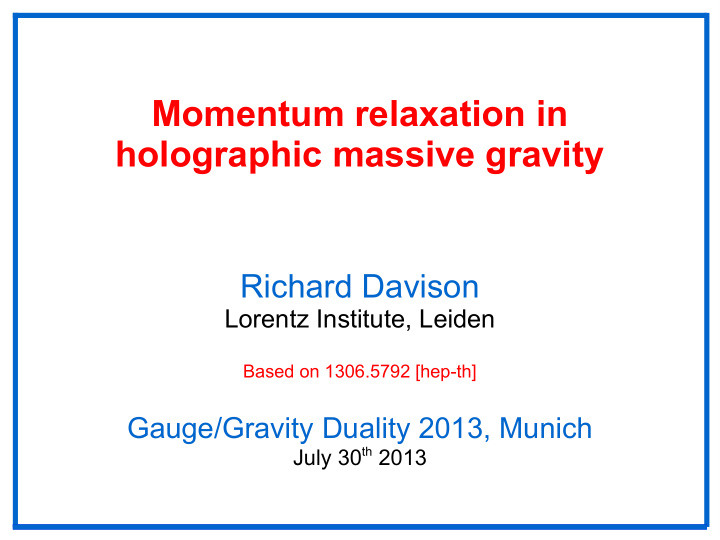



Momentum relaxation in holographic massive gravity Richard Davison Lorentz Institute, Leiden Based on 1306.5792 [hep-th] Gauge/Gravity Duality 2013, Munich July 30 th 2013
Introduction and motivation We want to use gauge/gravity duality to understand the observed properties of real materials. In real materials, momentum is not conserved. This has important qualitative effects on some observables. e.g. Conductivity in a theory with a conserved density of charge and no momentum dissipation: and because the charge will accelerate indefinitely under an applied field. With momentum dissipation, the DC conductivity is finite and the delta function spreads out.
Introduction and motivation It is therefore important that our gravitational models can incorporate the dissipation of momentum. This can be achieved, for example, by including a lattice structure in the equilibrium state, or by coupling the charge to impurities or a large amount of neutral matter. A new model was recently proposed. By giving a mass to the bulk graviton, momentum is no longer conserved in the field theory. Vegh 1301.0537 [hep-th] This is an attractive toy model because it is simple. The AC conductivity at shares some appealing features with other holographic and experimental systems.
Outline of this talk The question I will address: what are the main effects of the graviton mass term on the basic transport properties of the field theory? Outline of the talk ● Brief review of Vegh's massive gravity model ● Why the graviton mass produces momentum dissipation ● The effective theory incorporating momentum dissipation ● The AC conductivity: beyond the Drude model
Massive gravity: a brief introduction Couple the metric to a fixed reference metric via the action where . This specific choice generically removes the Boulware-Deser ghost. de Rham, Gabadadze, Tolley + many others Choose . This breaks diffeomorphism invariance in the x and y directions. There is a black brane solution D. Vegh
Excitations of massive gravity I will take a pragmatic approach and assume the existence of a dual field theory and use the usual holographic dictionary. Doing so produces sensible results for linear response properties. I will consider excitations (with energy and momentum ) of fields which are transverse to . There are four: gauge field metric In the massless case, there are only two independent, dynamical degrees of freedom These are the diffeomorphism-invariant combinations. The two-point functions of the dual operators and are therefore not independent. The relations between them are just the Ward identities due to energy-momentum conservation Kovtun, Starinets
Excitations of massive gravity In the massive case, there is no longer diffeomorphism invariance and and are truly independent bulk fields. The two-point functions of and are therefore independent and the Ward identities are violated: . Momentum is not conserved. What effect does this have on the low-energy observables? To answer this, consider the effective theory: hydrodynamics. At sufficiently low and , the massless theory is described by plus constitutive relations for and .
Modified hydrodynamics In the massive theory, momentum is not conserved and we must modify hydrodynamics. For small graviton masses, the main effect is to change the conservation equation to where is the momentum relaxation time. For a homogeneous fluid flow, For stability, we require that A very similar model was previously considered in the context of scattering from random impurities. Hartnoll, Kovtun, Muller, Sachdev 0706.3215 [cond-mat.str-el]
Collective modes of massive gravity How do we check if this is the correct effective theory? One check is to compare the excitations. The modified hydrodynamics has a collective transverse excitation with dispersion relation The transverse Green's functions computed from massive gravity have a pole with dispersion relation (for small ) We have agreement, and can determine the momentum relaxation time
The Drude model This gives a physical meaning to the graviton mass term: it controls the rate of momentum relaxation. For stability, . The momentum relaxation causes the current to relax. At small and , approximate the Green's function by the pole closest to the origin This gives the conductivity This is the same as the answer from the Drude model This result clearly applies more generally than in the Drude model. It relies only on the hydrodynamic structure just outlined.
AC conductivity of massive gravity We can compute the AC conductivity more precisely. At T=0 there is one dimensionless background parameter and The DC conductivity diverges in the massless limit and
AC conductivity of massive gravity In the small mass limit , the conductivity has the simple Drude form (equal to naive T=0 where limit of hydrodynamic formula) We also know the leading corrections away from this limit. exact numerical result Drude model result Drude model + corrections
Conclusions and future work Turning on mass terms for the graviton violates the conservation of momentum. The low energy theory (hydrodynamics) is modified so that the system dissipates momentum at a constant rate For small masses and frequencies, the conductivity is that of the Drude model. We have computed the leading corrections to this. Two important questions are 1). To what extent can we trust massive gravity? Can it be embedded in something that we understand better? 2). To what extent are the results realistic? Are they realised in any experimental or other theoretical systems?
Recommend
More recommend